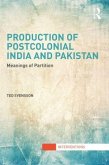This new study looks at the crucial role played by audiovisual media in Hindu cultural nationalism. The application of new media technology in the context of the construction of 'Indianness' by Hindutva's main political wing, the Bharatiya Janata Party (Party of the Indian People, BJP), is a fascinating example of in-house indoctrination and emotive mobilization that demands critical attention. At a time when public attention is focused on transnational, and mostly Islamicist, movements, Empowering Visions argues that both transnationalism and nationalism have to be treated with equal attention, and to some extent ought to be seen as intertwined processes. This book is unique in its presentation and discussion of profound ethnographic data through interviews with a variety of spokesmen for the Hindutva movement. It also offers an in-depth analysis of visual and audiovisual material that has so far been unrecognized and unexplored in scholarly works. The videos analysed have been included in massive public political spectacles such as election rallies and patriotic pilgrimages. With the help of these media, different political and cultural-religious organizations, subsumed under the umbrella of Hindutva, have attempted to constitute notions of 'Indianness' as 'Hinduness', to challenge and provoke both the government in power and specific minority groups such as the Muslims in India. How this was done, who stood behind the making of the videos and how they were produced and distributed, are questions that lie at the heart of this study.








